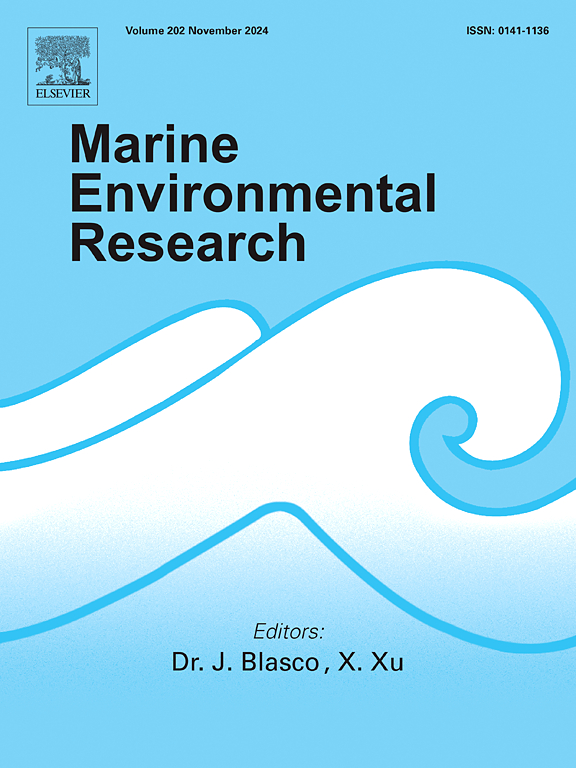Wind-tide modulated net ecosystem metabolism in a Changjiang River Estuary aquaculture zone during mid-autumn
IF 3.2
3区 环境科学与生态学
Q2 ENVIRONMENTAL SCIENCES
引用次数: 0
Abstract
The Changjiang River Estuary (CRE) supports critical fisheries and aquaculture industries. Net Ecosystem Metabolism (NEM) serves as a key indicator for assessing aquaculture ecosystem health, providing early warning of hypoxia risks, determining environmental carrying capacity, and guiding scientific aquaculture management. However, the hydrologic regime of the CRE, influenced by monsoons and strong tides, makes the combined effects of high-frequency wind and tidal variations on NEM dynamics poorly understood. In this study, we deployed a high-resolution in-situ profiler at a mussel aquaculture site in the CRE during September–October 2022 to continuously measure parameters, including dissolved oxygen (DO), at 1-min intervals. We then applied a one-dimensional DO mass balance model to quantify NEM variations and elucidate the driving mechanisms under contrasting wind and tidal conditions. Results indicated a predominantly heterotrophic ecosystem, with a mean NEM value of −6.0 ± 27.4 mmol m−2 h−1. Mechanistic analysis revealed that wind and tidal forces regulate NEM by modulating the frontal dynamics between the Changjiang River Diluted Water (CDW) and the Taiwan Warm Current (TWC). Northerly winds enhanced heterotrophy by intensifying CDW dominance and terrestrial organic matter inputs. In contrast, easterly winds coupled with spring tides promoted autotrophy through the onshore advection of shelf surface waters (SSW). Tidal cycles further regulated NEM through vertical mixing-mediated benthic nutrient output, resulting in higher autotrophy during spring tides. These findings, derived from high-frequency observations, highlight the acute sensitivity of estuarine metabolism to shifts in dominant water masses. They provide essential insights for adaptive management strategies, such as implementing real-time environmental monitoring and selecting species aligned with water mass dynamics, to enhance aquaculture sustainability amidst climate variability. Nevertheless, limitations in the temporal scope (mid-autumn period) and localized geography necessitate future investigations into seasonal/interannual NEM variations across broader spatial scales. Integrating wider drivers, including river discharge and climate change, will yield more robust data support and mechanistic analysis for developing predictive models.
长江口水产养殖区秋季风潮调节净生态系统代谢
长江口支撑着重要的渔业和水产养殖业。净生态系统代谢(NEM)是评价水产养殖生态系统健康状况、提供缺氧风险预警、确定环境承载能力、指导水产养殖科学管理的关键指标。然而,受季风和强潮影响的CRE水文制度使得人们对高频风和潮汐变化对NEM动力学的综合影响知之甚少。在这项研究中,我们于2022年9月至10月在CRE的一个贻贝养殖场部署了一个高分辨率的原位剖面仪,以1分钟的间隔连续测量参数,包括溶解氧(DO)。然后,我们应用一维DO质量平衡模型来量化NEM变化,并阐明在不同风和潮汐条件下的驱动机制。结果表明,该生态系统以异养为主,平均NEM值为−6.0±27.4 mmol m−2 h−1。机制分析表明,风和潮汐力通过调节长江冲淡水(CDW)和台湾暖流(TWC)之间的锋面动力学来调节NEM。北风通过增强CDW优势和陆源有机质输入增强了异养性。相比之下,东风和春潮通过陆架表层水(SSW)的陆上平流促进了自养。潮汐循环通过垂直混合介导的底栖生物养分输出进一步调节NEM,导致春潮期间自养能力增强。这些发现来自高频观测,强调了河口代谢对优势水团变化的急性敏感性。它们为适应性管理策略提供了重要的见解,例如实施实时环境监测和选择与水质量动态相一致的物种,以提高气候变化条件下水产养殖的可持续性。然而,由于时间范围(中秋期)和局部地理的限制,未来需要在更广泛的空间尺度上对季节/年际NEM变化进行调查。整合更广泛的驱动因素,包括河流流量和气候变化,将为开发预测模型提供更可靠的数据支持和机制分析。
本文章由计算机程序翻译,如有差异,请以英文原文为准。
求助全文
约1分钟内获得全文
求助全文
来源期刊

Marine environmental research
环境科学-毒理学
CiteScore
5.90
自引率
3.00%
发文量
217
审稿时长
46 days
期刊介绍:
Marine Environmental Research publishes original research papers on chemical, physical, and biological interactions in the oceans and coastal waters. The journal serves as a forum for new information on biology, chemistry, and toxicology and syntheses that advance understanding of marine environmental processes.
Submission of multidisciplinary studies is encouraged. Studies that utilize experimental approaches to clarify the roles of anthropogenic and natural causes of changes in marine ecosystems are especially welcome, as are those studies that represent new developments of a theoretical or conceptual aspect of marine science. All papers published in this journal are reviewed by qualified peers prior to acceptance and publication. Examples of topics considered to be appropriate for the journal include, but are not limited to, the following:
– The extent, persistence, and consequences of change and the recovery from such change in natural marine systems
– The biochemical, physiological, and ecological consequences of contaminants to marine organisms and ecosystems
– The biogeochemistry of naturally occurring and anthropogenic substances
– Models that describe and predict the above processes
– Monitoring studies, to the extent that their results provide new information on functional processes
– Methodological papers describing improved quantitative techniques for the marine sciences.
 求助内容:
求助内容: 应助结果提醒方式:
应助结果提醒方式:


